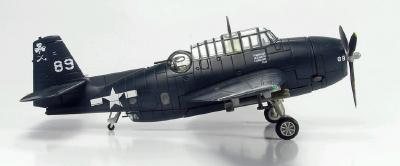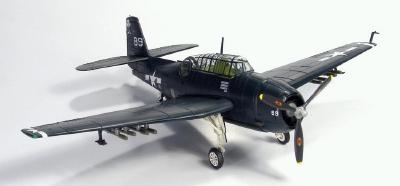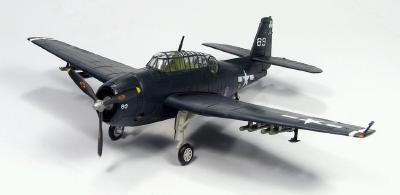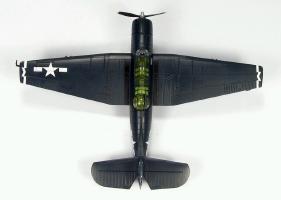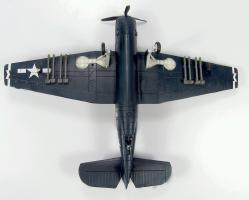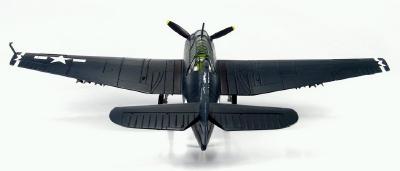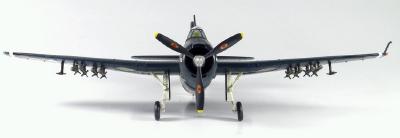Hobby Master Archive
Air Power Propellers 1/72
TBF/TBM
TBM-3 Avenger "White 89", VC-94, USS Shamrock Bay, Okinawa waters, 1945
Hobby Master 1/72 Air Power Series HA1207 TBM-3 Avenger “White 89”, VC-94 USS Shamrock Bay Okinawa waters, April 1945
Die-cast metal. Superb detailing in 1/72 scale. Pre-painted with pad applied markings. Fully assembled. Weapons are not permanently attached, missiles and torpedo. Bomb bay can be displayed open or closed. Display stand included. Option to display model with wheels up or down. Minimum use of plastic. Very collectable.
February 29, 1944 VC-94 was commissioned and joined USS Shamrock Bay December 10, 1944. Part of January 1945 was spent supporting the assault on the Philippines with 571 sorties. The next 2 months they escorted Logistic Groups building for Operation “Iceberg”, the assault on Okinawa. Throughout April off the coast of Okinawa the VC-94 flew over 1,000 sorties bombing and rocketing artillery, caves, troops and small boats. On May 11, 1945 the ship sailed to Guam where VC-94 was relieved by VC-96 and on the 27th the ship returned to the US.
History behind the Grumman Avenger On the afternoon of December 7, 1941, Grumman opened a new manufacturing plant and that will live in infamy" when the Imperial Japanese Navy attacked Pearl Harbor. After the ceremony, the plant was quickly sealed off to prevent any possible enemy action. Grumman’s first torpedo bomber was the heaviest single-engine plane of WWII, and it was the first to feature a new Grumman designed folding wing mechanism that would greatly increase storage space on an aircraft carrier. Another Grumman aircraft to utilize this folding wing was the F6F Hellcat. There were three crew members–pilot, turret gunner, and radioman/bombardier/ventral gunner. Equipped with a .50-caliber machine gun in each wing, one .50 caliber gun mounted right next to the turret gunner’s head in a rear-facing electrically-powered turret. A single .30 caliber hand-fired machine gun mounted under the tail was available to defend against enemy fighters attacking from a below and to the rear. This gun was fired by the radioman/bombardier while standing up and bending over in the belly of the tail section but he usually sat on a folding bench facing forward to operate the radio and to sight in bombing runs. Equipped with a large bomb bay the Avenger could hold a torpedo, a single 2000 lb bomb, or up to four 500 lb bombs. By 1944, it was rare for American aircraft to encounter enemy shipping so the Avenger was used mostly as a ground support weapon. The most notable features of the Avenger was its ruggedness and ease of handling best described by the pilots as flying a truck. Along with the normal role of torpedoing surface vessels Avengers sent some thirty submarines to the bottom. One such sub was the cargo submarine I-52 whose wreck was located in 1998. Recognized as one of the most effective sub killers in the Pacific the Avenger was put to work in the Atlantic protecting convoys from U-boats once Escort Carriers were made available. The Avenger was also used by the Royal Navy’s Fleet Air Arm where it was first known as the “Tarpon” but eventually was referred to as the Avenger. The first 402 aircraft were known as Avenger Mk 1, 334 TBM-1s were the Avenger Mk II and 334 TBM-3 as Mark III. Post war the antisubmarine version was the “Avenger AS Mk IV” in RN service. One other military used the Avenger in WWII, the Royal New Zealand Air Force operating from South Pacific islands as bombers.
Specifications for the Avenger General characteristics - Dimensions - Length: 40 ft. 11.5 in. (12.48 m) Wingspan: 54 ft. 2 in. (16.51 m) Height: 15 ft. 5 in. (4.70 m) Wing area: 490.02 ft. sq. (45.52 m sq.) Weight - Empty: 10,545 lb. (4,783 kg) Loaded: 17,893 lb. (8,115 kg) Power plant: 1 Wright R-2600-20 radial engine producing 1,900 hp (1,420 kW) Performance - Maximum speed: 276 mph (444km/h) Range: 1,000 miles (1,610 km) Service ceiling: 30,100 ft (9,170 m) Rate of climb: 2,060 ft/min (10.5 m/s) Wing loading: 36.5 ft-lbf sq (178 kg/m sq) Armament - 1x 0.30 cal (7.62 mm) nose-mounted machine gun 2 x 0.50 cal (12.7 mm) wing-mounted machine guns 1 x 0.50 cal (12.7 mm) dorsal-mounted machine gun 1 x 0.30 cal (7.62 mm) ventral-mounted machine gun Up to 2,000 lb (900 kg) of bombs 1 x 2,000 lb (900 kg) torpedo
THESE ARE ONLY PRE-PRODUCTION PICTURES NOT THE FINAL PROUCT
| Added to archive | 2016-08-01 |
| Last modified | 2016-08-01 |
